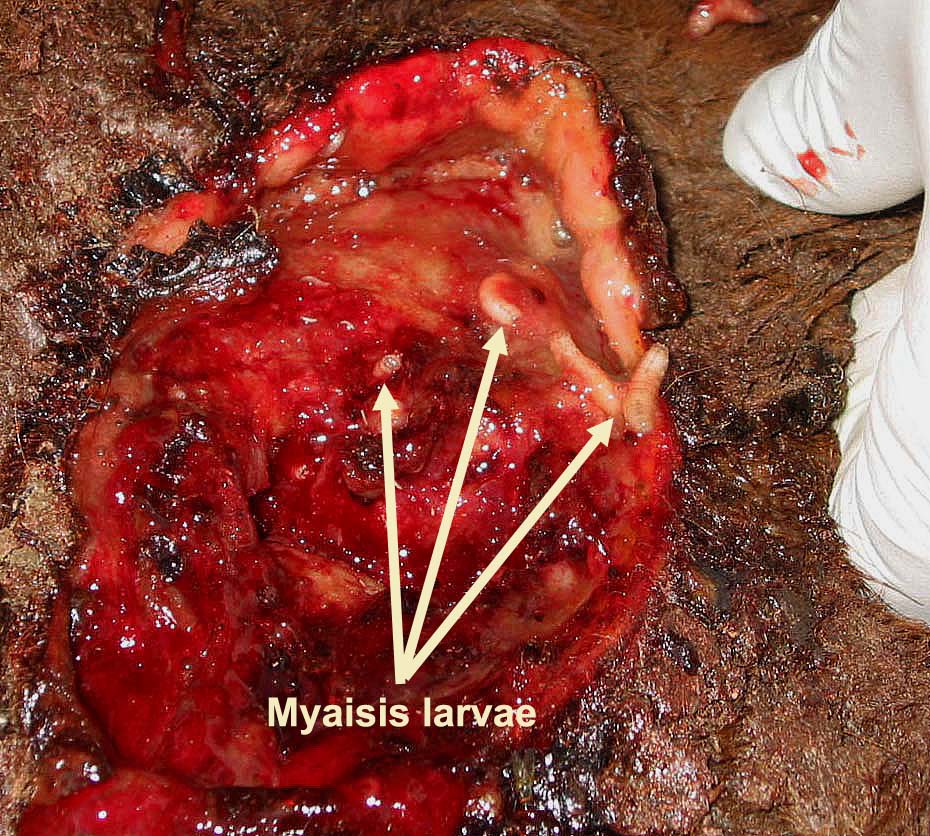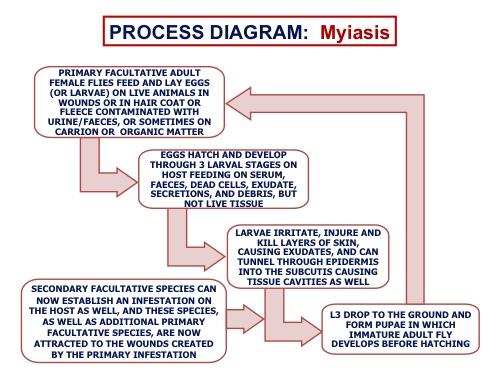Myiasis
Myiasis is the infestation of living vertebrates with the larvae of flies, the species of which vary with location around the world.
Overview
Myiasis is the infestation of living vertebrates with the larvae of flies, the species of which vary with location around the world. The term myiasis is usually applied to those genera of flies that opportunistically invade the skin and sub-cutaneous tissues of people, domestic animals and wildlife, but sometimes invade deeper tissues. The larvae of warble and bot flies (e.g. Gasterophilus of horses and Hypoderma of cattle) migrate through the tissues of the host, but are not usually associated with skin lesions. The larvae causing myiasis must feed on the tissues of affected animals, sometimes causing serious clinical problems, and even death. The animals develop myiasis when the adult female flies are attracted to a wound or to macerated skin contaminated with urine and/or faeces, where they lay eggs (or larvae - Wohlfahrtia species). On the animals, the eggs hatch and develop through three larval stages. The third-stage larvae, whose feeding activities can seriously damage the host, drop to the ground, where they form pupae in which the immature adult flies develop before hatching. Neglected or immobile animals are particularly susceptible to myiasis as they are unable to fend off the adult flies or remove the eggs and larvae.
The flies associated with myiasis can be classified into two groups: 1) obligate - those that must develop on live hosts (e.g. Wohlfahrtia vigil - flesh flies); and 2) facultative - those that can develop in either live or dead hosts or in organic matter. Genera causing facultative myiasis are further classified as primary, which can initiate myiasis (e.g. Lucilia species - blow flies/greenbottles), or as primary and secondary (e.g. Lucilia species, Calliphora species - blow flies/bluebottles, Phormia species - blow flies/blackbottles, and Wohlfahrtia species), which require obligate or primary genera to initiate the infestation. All these genera occur in Canada.
Myiasis in Dogs and Cats

Myiasis is a significant problem in dogs, and to a lesser extent cats (whose self-grooming activities help to prevent the infestation) in many parts of the world, including Canada. The condition tends to be more common and more serious where and when warmth and humidity favour the flies and where care of the animals might be sub-optimal. Lesions occur anywhere on the body, but seem to be more common close to natural openings, and are often crater-like and can extend into the underlying tissues. While the opening to the lesion can be obscured by the hair coat, the often numerous larvae within the lesions are obvious. Treatment involves removing as many of the maggots as possible, cleaning and perhaps debriding the wound (fly maggots are sometimes used deliberately to debride wounds in people), perhaps administering an insecticide, either locally (very carefully), or systemically, and dealing with the issues underlying the development of the myiasis (care and cleanliness). Systemic treatment with macrocyclic lactones (such as ivermectin, moxidectin) can be highly effective.

Note: Dogs and sometimes cats can also be affected by a fly bite dermatitis, which can be a significant clinical problem. This is caused by the bites of biting flies, and seems most common on the ears and face. Erythema, scabbing, and pruritus are the most common symptoms.
Finally, the obligate myiasis flies known as screwworms feed on living flesh of dogs and many other mammals, often invading natural wounds or castration sites. These screw worms are not currently endemic to North America. Introduction of larvae of these flies in infested dogs imported from the Old World (Chrysomya bezziana) and New World (Cochliomyia hominivorax) is of great concern for both animal and human health. Dogs traveling from endemic areas should be carefully inspected and any fly larvae should be identified to rule out screwworm. Affected animals should be treated with a macrocyclic lactone prior to import. The New World screwworm has successfully been held south of the Panama Canal through the release of sterile male flies, taking advantage of the fact that the female fly mates only once, leading to local collapse of fly populations. The New World screwworm is a reportable animal disease in the USA and veterinary certification is required to import dogs from endemic regions (Central and South America) (https://www.aphis.usda.gov/aphis/pet-travel/bring-pet-into-the-united-states/dog-import-pets)

